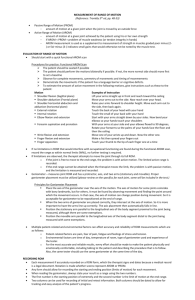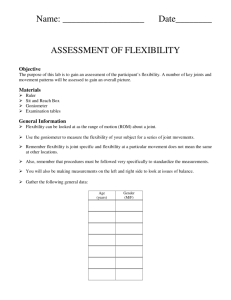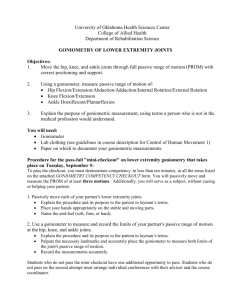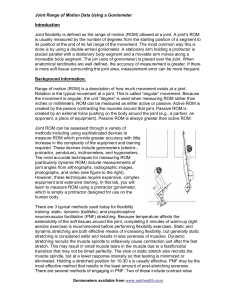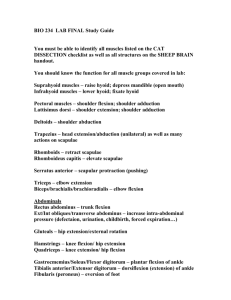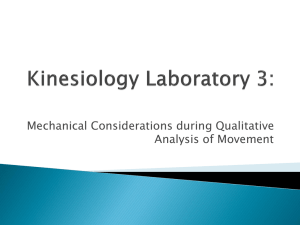Kinesiology 173 Anatomical Movement Lab
advertisement
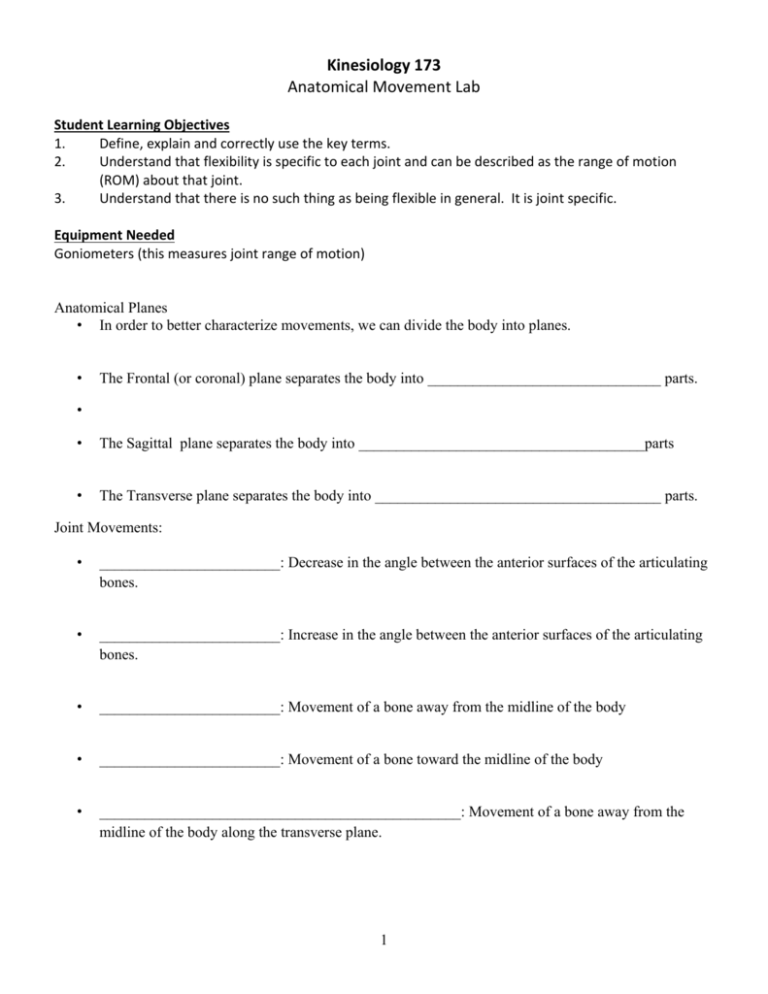
Kinesiology 173 Anatomical Movement Lab Student Learning Objectives 1. Define, explain and correctly use the key terms. 2. Understand that flexibility is specific to each joint and can be described as the range of motion (ROM) about that joint. 3. Understand that there is no such thing as being flexible in general. It is joint specific. Equipment Needed Goniometers (this measures joint range of motion) Anatomical Planes • In order to better characterize movements, we can divide the body into planes. • The Frontal (or coronal) plane separates the body into _______________________________ parts. • • The Sagittal plane separates the body into ______________________________________parts • The Transverse plane separates the body into ______________________________________ parts. Joint Movements: • ________________________: Decrease in the angle between the anterior surfaces of the articulating bones. • ________________________: Increase in the angle between the anterior surfaces of the articulating bones. • ________________________: Movement of a bone away from the midline of the body • ________________________: Movement of a bone toward the midline of the body • ________________________________________________: Movement of a bone away from the midline of the body along the transverse plane. 1 • ________________________________________________: Movement of a bone toward the midline of the body along the transverse plane. • ________________________________________________: Rotation away from the midline of the body. • ________________________________________________: Rotation toward the midline of the body • ________________________: Rotation of the palm anteriorly. Facing up. • ________________________: Rotation of the palm posterior: Facing down. • ________________________: Movement of the sole of the foot inward at the ankle joint. • ________________________: Movement of the sole of the foot outward at the ankle joint. • ________________________: Flexion of the foot at the ankle joint. • ________________________: Extension of the foot at the ankle joint. • ________________________: Movement in which the distal end of a bone moves in a circle while the proximal end remains stable. Overview All students will assess their flexibility with use of the goniometer. Students should pair up with a classmate and take measurements on one another. Assessments will be made of the wrist, shoulder, hip, and hamstring/hip. Each joint range of motion (ROM) targeted below in the protocol will describe the starting position, where to place the goniometer, the direction in which the joint should be moved, and hints for accurate ROM measurements. Furthermore—you will not be assessing every joint angle possible in this lab. This lab is intended to give you some experience assessing ROM in the major joints, using a few possible actions (e.g. flexion) 2 Protocol 1. Wrist – Extension a. Starting position: Forearm flat against table, palm facing down. b. Goniometer placement: -- Place the pivot point of the goniometer at the base of the palm. -- Place one of the goniometer arms parallel to the forearm. -- Place the other goniometer arm parallel to the palm. c. Movement: Subject extends the wrist up away from the table and holds this position until measurement is completed. 2. Shoulder joint – flexion a. Starting position: Subject laying supine, arms at sides, and palms facing the body. b. Goniometer placement --Place the pivot point of the goniometer on the center of the subject’s shoulder just below the acromion process (bony end/tip of shoulder). You can palpate this bony landmark by feeling the tip of the shoulder. The acromion process articulates (meets) with the clavicle, creating the acromioclavicular joint. c. --Place one of the goniometer arms parallel to the mid-axillary line of the subject’s trunk. --Place the other goniometer arm parallel to the longitudinal axis of the subject’s humerus along their side. Movement --Subject flexes the dominant arm in sagittal plane. --Subject holds this position until measurement is completed. 3 d. Precautions --Keep trunk motionless. Do not allow trunk extension, lordosis (inward curvature of back), or shoulder abduction (away from shoulder). 3. Shoulder Joint – Extension a. Starting position --Laying on belly with arms at sides, palms facing the body. b. Goniometer placement --Place the pivot of the goniometer on the center of the subject’s shoulder below the acromion process. --Place one of the goniometer arms parallel to the mid-axillary line of the subject’s trunk. --Place the other goniometer arm parallel to the longitudinal axis of the subject’s humerus along the lateral side. c. Movement --Subject extends the dominant arm back as far as possible without rotating the trunk and abducting the shoulder. --Hold position until measurement is completed. d. Precautions --Avoid trunk rotation and shoulder abduction. 4. Shoulder joint – Horizontal Internal rotation Note—pictures below do not show a seated position, but are used for illustrative purposes to indicate position of shoulder/elbow/direction of movement/and placement of goniometer. a. Starting position (seated) --Abduct (away from body) the dominant arm to 90 degrees. --Flex elbow at 90 degrees at shoulder height. 4 --Face palm downward (pronated). --Arm should be parallel with body (see picture below) b. Goniometer placement --Place the pivot of the goniometer on the center of the elbow joint. --Place one of the goniometer arms parallel to the floor. --Place the other goniometer arm parallel to the longitudinal axis of the ulna. c. Movement --Administrator keeps subject’s elbow directly lateral to subject’s shoulder while gently pushing wrist down and back until tightness if felt.. --Position is held until measurement is made. 5. Shoulder joint –Horizontal External rotation a. Starting Position—same as internal rotation, with the exception that the arm is parallel to the floor. b. Goniomter Placement --Place the pivot of the goniometer on the center of the elbow joint. --Place one of the goniometer arms parallel to the floor. --Place the other goniometer arm parallel to the longitudinal axis of the ulna (long bone of forearm (pinkie side)). c. Movement --Move the dominant forearm upward and as far past shoulder til point of tension. --Hold this position until the measurement is made (do not move trunk). 5 6. Hip Joint – Flexion (Bent knee) a. Starting Position --Lie on back with both legs straight. b. Goniometer placement --Place the pivot of the goniometer on the center of the greater trochanter. --Place one of the goniometer arms parallel to the floor. --Place the other goniometer arm parallel to the axis of the femur (long bone of thigh). c. Movement --Slowly flex the dominant leg. d. Precautions --Avoid flexion of the non-dominant hip. --Avoid internally rotating the dominant hip. --Do not grasp the knee. longitudinal 7. Your Choice - Select 2 additional joint measurements to try from the following pages. How does your flexibility compare with the expected ROMs ? 6 RANGE OF MOTION MEASUREMENTS: Shoulder Flexion: Measurement Tool: Testing Position: Stabilization: Goniometer Axis: Stationary Arm: Moving Arm: Movement: Expected ROM: Substitutions: Universal Goniometer Supine with hips and knees bent and lumbar spine flat. Arm is at the side with the palm in and the thumb up Body weight should stabilize scapula but manual stabilization may be required to prevent excessive scapular rising and tipping posteriorly Lateral aspect of the center of the humeral head approximately 1" below the acromion process Parallel to midaxillary line of the trunk Parallel to longitudinal axis of the humerus pointing toward the lateral epicondyle Shoulder flexion 120° of pure GH flexion; 150° with GH, AC, SC, and scapulothoracic contribution; 180° if lumbar hyperextension permitted Lumbar hyperextension Scapular tipping Maintain slight elbow flexion so that long head of triceps does not restrict motion Shoulder Abduction: (note plane of movement - scapular vs. frontal plane of elevation) Measurement Tool: Testing Position: Universal Goniometer Supine with the hips and knees bent. Arm is in the anatomical position with the shoulder externally rotated Stabilize the thorax Anterior aspect of the shoulder just inferior and lateral to the coracoid process Parallel to midaxillary line of the trunk Anterior aspect of the upper arm parallel to longitudinal axis of the humerus Shoulder elevation in scapular or frontal plane 90° of pure GH abduction; 150° with GH, AC, SC, and scapulothoracic contribution; 180° if lumbar lateral flexion is allowed Lumbar lateral flexion Excessive scapular upward rotation contribution to movement Stabilization: Goniometer Axis: Stationary Arm: Moving Arm: Movement: Expected ROM: Substitutions: Shoulder Internal/External Rotation Measurement Tool: Testing Position: Stabilization: Goniometer Axis: Stationary Arm: Moving Arm: Movement: Expected ROM: Substitutions: Universal Goniometer Supine with the shoulder and elbow abducted 90°. The forearm is midway between pronation/supination with the entire humerus is supported by the table. Stabilize the distal humerus through the full ROM and stabilize the thorax/scapula at the end ROM The olecranon process of the ulna projecting through the humeral shaft toward the humeral head Parallel to the supporting surface or perpendicular to the floor Parallel to the longitudinal axis of the ulna pointing toward the styloid process Internal and External Rotation 70° internal rotation; 90° external rotation Elbow extension, scapular elevation, tilting, or protraction The amount of motion available is influenced by the position of abduction in the frontal plane and whether the measurements are performed in the scapular or frontal planes. Specifically record the position during measurement. Shoulder Horizontal Abduction: Measurement Tool: Testing Position: Stabilization: Goniometer Axis Stationary Arm: Moving Arm: Movement: Expected ROM: Substitutions: Universal Goniometer Supine with the hips and knee bent and the shoulder abducted 90° and the elbow flexed 90° Stabilize the thorax to prevent lateral lumbar flexion or trunk roll Superior surface of the acromion Perpendicular to the floor projecting towards the floor Parallel to the longitudinal axis of the humerus pointing toward the lateral epicondyle Horizontal abduction 45° Trunk Rotation Elbow Flexion: Measurement Tool: Testing Position: Stabilization: Goniometer Axis: Stationary Arm: Moving Arm: Movement: Expected ROM: Stabilization: Note: Universal Goniometer Supine or sitting with the arm parallel to the midline and the forearm in the anatomical position Examiner manually stabilizes the humerus Over the lateral epicondyle of the humerus Parallel to the longitudinal axis of the humerus pointing towards the tip of the acromion Parallel to longitudinal axis of the radius pointing toward the styloid process of the radius Elbow flexion 150° Prevent shoulder flexion If he forearm cannot be placed in full supination, note the position of testing Elbow Extension: Measurement Tool: Testing Position: Stabilization: Goniometer Axis: Stationary Arm: Moving Arm: Movement: Expected ROM: Stabilization Note: Universal Goniometer Supine or sitting with the arm parallel to the midline and the forearm in the anatomical position Examiner manually stabilizes the humerus Over the lateral epicondyle of the humerus Parallel to the longitudinal axis of the humerus pointing towards the tip of the acromion Parallel to the longitudinal axis of the radius pointing towards the styloid process of the radius Elbow extension 0° in males; 10-15° in females is common. Prevent scapular tilting if hyperextension range is available, a towel roll can be placed under the humerus Forearm Pronation/Supination: Measurement Tool: Testing Position: Stabilization: Goniometer Axis: Stationary Arm: Moving Arm: Movement: Expected ROM: Substitutions: Universal Goniometer Sitting with the shoulder adducted to the side and the elbow flexed 90° with the forearm in the neutral “hand shake” midposition. Examiner stabilizes the humerus and does not allow abduction or adduction Just medial and posterior (supination) or lateral and posterior (pronation) to the ulnar styloid process Parallel to the long axis of the humerus Parallel to the dorsal forearm surface in pronation and volar surface in supination External motion into full supination and internal motion into full pronation 80-90° of pronation and supination Supination: wrist extension and/or radial deviation, adduction and ER of the shoulder, and ipsilateral trunk lateral flexion Pronation: wrist flexion and/or ulnar deviation, abduction and IR of the shoulder, and/or contralateral trunk lateral flexion Wrist Flexion-Extension: Measurement Tool: Testing Position: Stabilization: Goniometer Axis: Proximal Arm: Distal Arm: Movement: Expected ROM: Substitutions: Universal Goniometer Elbow flexed 90°; Wrist over edge of table with forearm in full pronation Forearm stabilized to prevent pronation or supination Lateral placement over the triquetrum Parallel with the ulna bisecting the ulnar styloid, radial head, and lateral epicondyle Parallel to longitudinal axis of the fifth metacarpal Wrist flexion with fingers extended and extension with fingers comfortably flexed 75° for both flexion and extension Excessive radial or ulnar deviation Wrist Radial-Ulnar Deviation: Measurement Tool: Testing Position: Stabilization: Goniometer Axis: Proximal Arm: Distal Arm: Movement: Expected ROM: Substitutions: Universal Goniometer Elbow flexed 90°; Wrist over edge of table with forearm in full pronation Forearm stabilized to prevent pronation, supination, or shoulder rotation Dorsal capitate Dorsal midline of the forearm Parallel to longitudinal axis of the third metacarpal Frontal plane motion in medial and lateral directions 20° radial deviation and 30° ulnar deviation MCP abduction or adduction Hand Range of Motion Motion Recommend ed Testing Position Proximal Arm Distal Arm Over dorsal MCP joint Dorsal midline of metacarpal Dorsal midline of proximal phalanx Stabilize wrist to prevent proximal motion Over dorsal MCP joint Dorsal midline of metacarpal Dorsal midline of proximal phalanx Sitting with hand off table and forearm, wrist, and MCP in neutral. Sitting with hand off table and wrist in neutral Stabilize proximal phalanx Over dorsal PIP joint Dorsal midline of proximal phalanx Dorsal midline of middle phalanx Stabilize middle phalanx Over dorsal DIP joint Dorsal midline of distal phalanx Sitting with supinated on table and forearm and wrist in neutral Stabilize carpal bones to prevent wrist motions Palmar aspect of 1st CMC joint Sitting with ulnar border of hand on table and forearm, wrist in neutral Stabilize carpal bones & second metacarpal to prevent wrist motions Lateral aspect of radial styloid process Dorsal midline of middle phalanx Ventral midline of radius using ventral surface of theradial head and styloid for reference Lateral midline of 2nd metacarpal. Reference center of 2nd MCP joint Stabilization Axis Sitting with hand off table and forearm and wrist in neutral. Stabilize metacarpals to prevent wrist motion. Do not hold other fingers in extension. MCP AbductionAdduction Sitting with hand off table and forearm in full pronation and wrist in neutral PIP FlexionExtension MCP Flexion Extension DIP FlexionExtension st 1 CMC Palmar FlexionExtension st 1 CMC Palmar AbductionAdduction Opposition st 1 MCP Flexion st 1 IP Flexion Sitting with ulnar border of hand on table and forearm, wrist in neutral Sitting with ulnar border of hand on table and forearm, wrist in neutral Stabilize 5th metacarpal to prevent wrist motions Stabilize 1st metacarpal to prevent wrist motion and flexion and position of thumb CMC Stabilize proximal phalanx to prevent flexion or extension of MCP Ventral midline of 1st metacarpal Lateral midline of 1st metacarpal Reference center of 1st MCP joint Expected ROM 30-0-90° 20-0-20° 0-100° 0-70° 30-0-10° 70° Use ruler to measure distance between tip of thumb and 5th finger Dorsal aspect of MCP Dorsal midline of metacarpal Dorsal midline of proximal phalanx Dorsal surface of IP Dorsal aspect of proximal phalanx Dorsal midline of distal phalanx 0-50° 0-80° Start End End Spinal Inclinometry: Objective Measurement of Lumbar Spine Position and Range of Motion Dual Inclinometer Technique One inclinometer is placed over the sacrum and the other over T12-L1 spinous processes while the patient is standing in a relaxed erect posture. As with other techniques that require locating anatomical landmarks, the accuracy of the readings is markedly decreased with obese patients. Angular readings are taken while holding the inclinometers in place while the patient is in the upright relaxed position. The patient is then instructed to maximally flex forward while the new angular readings are taken in the fully flexed position. The patient is instructed to continue forward bending until the pelvic motion is within 20% of the straight leg measurement used to determine hamstring flexibility. The upper inclinometer reading represents gross motion while the lower inclinometer measures pelvic or hip motion. True lumbar motion is represented by the difference between these two measurements. Single Inclinometer Technique: Method 1: The same technique as above is utilized except that the inclinometery measurements must be made at each site independently. Method 2: The examiner’s hands span the anterior and posterior parts of the iliac crest to allow measurement of pelvic mobility. The index finger of one hand is placed parallel to the floor along the top of the iliac crest. The opposite hand is holding the inclinometer at the T12-L1 interspace. The patient performs the same forward bending motion after the initial reading. Total motion is recorded from the inclinometer. The inclinometer is then placed across the plane connecting the thumb and index finger to determine pelvic motion. Calculation of pelvic and lumbar contribution to total motion is then calculated in the same way as with the dual inclinometer technique. Extension range of motion is then measured in the same way as described above except the patient’s motion is in the direction of extension. Source: Mayer, et al. Spine 9(6), 1984. This method was shown to be reliable and have no statistical difference form radiographic determination of lumbar range of motion. Linear Assessment of Lumbar Motion with Tape Measure Vertebral Distraction (flexion) and Attraction (extension) Anatomical landmarks (spinous processes) are identified and marked. A tape measure measurement is made of the distance between the two points. The patient is asked to flex or extend the spine and the new distance between the two points is remeasured. With flexion, the two points will be further apart, conversely, with extension the two points will approximate. The difference between the first and second measurement is an objective assessment of segmental or regional spine mobility between the initial anatomical landmarks. Sources: Beattie, et al. Phys Ther 67(3), 1987. Attraction tape measurement method demonstrated testretest reliability and it differentiated normals from those with “significantly limiting low back pain”. Intratester ICC = .95; Intertester ICC = .94 Balogun, et al. J Ortho Sports Phys Ther. 10(7), 1989. Compared gravity referenced goniometry to tape measurements of cervical range of motion. Both methods showed poor reliability with cervical flexion and good reliability with all other motions. Authors concluded that tape measurement was preferable because of its lower cost. Tape measure mean normals: Flexion Extension 4.3 cm 18.5 cm (R) LF (L) LF 12.9 cm 12.8 cm (R) Rot (L) Rot 11 cm 11 cm Chany-Yu, et al. J Ortho Sports Phys Ther 8(2), 1986. Also showed tape measure cervical range of motions to have a high intratester reliability for all motions (ICC = .80-.95). Toe Touch Test The patient stands on a platform and maximally bends forward towards the toes with the knees extended. A measurement is taken from the fingertips to the platform surface. This value can be positive or negative. The value is positive when the patient can reach beyond the platform surface. Source: Kippers, et al. Phys Ther. 67(11), 1987. Studied the reliability of fingertip to floor distance and found excellent intertester reliability (ICC = .97). However, the reliability of vertebral flexion was very poor (ICC = .10). The authors concluded that at maximum trunk flexion, fingertip to floor distance is primarily a measure of hamstring flexibility. They suggest alternative methods for assessing lumbar mobility. Assessment of Lumbar Lordosis Flexible Ruler A flexible cylindrical material is molded to the lumbar spine with markings at the L1-L2 and L5S1 interspaces. The flexible ruler is then traced onto a piece of paper to determine the angle of the flexible ruler that in theory would be equal to the actual lumbosacral angle. Source: Hart, et al. J Ortho Sports Phys Ther. 8(4), 1986. Found good intertester reliability with this method (ICC = .97). They also established validity (r = .87) when compared to radiographic studies in a small sample (n = 6). Bryan, et al. J Ortho Sports Phys Ther. 11(1), 1989. Found the flexible ruler has questionable clinical value in the assessment of lumbar lordosis or the actual lumbosacral angle. Average angles when measured between L1-2 and L5-S1 were 42° and 67° when measured from superior border of L1 and superior border of S1. Lovell, et al. Phys Ther. 69(2), 1989. Reliability Study of Flexible Ruler Intratester Reliability – Examiner 1 Intratetester Reliability – Examiner 2 Intertester Reliability LBP (ICC) Normals (ICC) .84 .73 .43 .94 .83 .50 Rheault, et al. J Ortho Sports Phys Ther. 10(7), 1989. Found good intertester reliability using the spinocurve flexible ruler for measuring cervical range of motion. They used the occiput and C7 as anatomical landmarks. Intertester reliability in neutral was .80 and .90 in full cervical flexion. No attempt was made to establish validity. Visual Assessment of Lordosis: Visual or photographic assessment of sagittal plane posture. Source: Bryan, et al. J Ortho Sports Phys Ther. 12(1), 1990. This study showed a 9% accuracy in ranking the amount of lumbar lordosis in clothed subjects. The strongest trend in interested reliability was the rater’s perception of increased lordosis might have been influenced by the gluteal prominence. Hip Flexion: Measurement Tool: Testing Position: Stabilization: Goniometer Axis: Proximal Arm: Distal Arm: Movement: Expected ROM: Substitutions: Universal Goniometer Supine with hips and knees in neutral rotation Trunk stabilized by body position Femoral Greater Trochanter Parallel to midaxillary line of the trunk Parallel to longitudinal axis of the femur in line with lateral femoral condyle Hip flexion with knee flexion allowed 120° Lumbar Spine flexion Hip Extension: Measurement Tool: Testing Position: Stabilization: Goniometer Axis: Proximal Arm: Distal Arm: Movement: Expected ROM: Substitutions: Universal Goniometer Prone with hips & knees in neutral and feet extending off end of the table Pelvis is stabilized through straps or manual fixation Greater Trochanter Parallel to midaxillary line of the trunk Parallel to longitudinal axis of femur in line with lateral femoral condyle Hip extension with knee extended. ASIS must remain on table. 30° Lumbar spine extension Hip Abduction: Measurement Tool: Testing Position: Stabilization: Goniometer Axis: Proximal Arm: Distal Arm: Movement: Expected ROM: Substitutions: Universal Goniometer Supine with hips and knees in neutral and pelvis level Opposite innominate ASIS on measured side Along a line between the two anterior superior iliac spines Parallel to the long axis of the femur Abduction until motion is detected at the opposite anterior superior iliac spine 45° Hip external rotation, knee flexion/internal rotation, or lateral pelvic tilt Hip Adduction: Measurement Tool: Testing Position: Stabilization: Goniometer Axis Proximal Arm: Distal Arm: Movement: Expected ROM: Substitutions: Universal Goniometer Supine with the opposite extremity abducted prn ASIS on measured side Along a line between the two anterior superior iliac spines Parallel to the long axis of the femur Adduction 30° Hip internal rotation or lateral pelvic tilt Hip Internal and External Rotation: Measurement Tool: Testing Position: Stabilization: Goniometer Axis: Proximal Arm: Distal Arm: Movement: Expected ROM: Substitutions: Universal Goniometer Sitting with the hip and knee flexed 90°. Opposite extremity abducted and resting on a foot stool prevent thigh abduction/adduction mid-patella Perpendicular to the floor Parallel to long axis of the tibia internal and external ROM 45° internal and external ROM thigh abduction/adduction Alternate Test Position for Hip Internal/External Rotation: Test Position: Stabilization: Diagnostic Findings: prone with knees flexed 90° strap or manual fixation of pelvis similar measurements with hips flexed or extended indicate structural limitations while different amounts of motion in each position may indicate soft tissue tightness of the hip flexors/extensors Knee Flexion: Measurement Tool: Testing Position: Stabilization: Goniometer Axis: Proximal Arm: Distal Arm: Movement: Expected ROM: Alternate Position: Universal Goniometer Supine or reclined with hip and knee in neutral rotation Trunk and pelvis stabilized by body weight and position Lateral epicondyle of the femur Parallel to the long axis of the femur & pointing at the greater trochanter Parallel to the long axis of the fibula and pointing at the lateral malleolus The hip and knee are flexed as the heel moves toward the buttock 135° Prone lying with the femur stabilized. Knee flexion motion may be decreased as the rectus femoris is now stretched over two joints. Prevent substitute motion of hip abduction and/or hip flexion. Knee Extension: Measurement Tool: Testing Position: Stabilization: Goniometer Axis: Proximal Arm: Distal Arm: Movement: Expected ROM: Alternate Position: Universal Goniometer Supine with hips and knees in neutral rotation; distal leg on bolster Trunk and pelvis stabilized by body weight and position Lateral Epicondyle of the femur Parallel to the long axis of the femur & pointing at the greater trochanter Parallel to the long axis of the fibula and pointing at the lateral malleolus Knee extension 0°. Hyperextension may be present up to 10-15° Prone lying heel height technique Tibial Internal/External Rotation: Measurement Tool: Testing Position: Stabilization: Goniometer Axis: Stationary Arm: Moving Arm: Movement: Expected ROM: Universal Goniometer Prone lying with knee flexed 90 degrees Therapist manually stabilizes the femur Parallel to the long axis of the tibia Parallel to the long axis of the tibia Parallel to and in line with the bisection of the heel and the 2nd metatarsal shaft Internal and external tibial rotation 30° internal and 40° external range of motion. It is difficult to establish neutral rotation and it may be more test-retest reliable to record the total ROM Talocrural Dorsiflexion: Measurement Tool: Testing Position: Stabilization: Goniometer Axis: Proximal Arm: Distal Arm: Movement: Expected ROM: Substitutions: Alternate Test: Universal Goniometer Prone with ankle off edge of table and knee extended Manual stabilization of tibia against the supporting surface Lateral calcaneus at bisection of fibula and 5th metatarsal Parallel to the long axis of the fibula and pointing towards the fibular head Parallel to the long axis of the 5th metatarsal The ankle is actively dorsiflexed 10° with knee extended; increased to 20 with the knee flexed Therapist must monitor for subtalar pronation. Watching for calcaneal eversion can monitor this. The above procedure should be repeated with the knee flexed 90° to isolate soleus flexibility. A 10° increase in ROM to 20° should be expected Talocrural Plantarflexion: Measurement Tool: Testing Position: Stabilization: Goniometer Axis: Proximal Arm: Distal Arm: Movement: Expected ROM: Alternate Position: Universal Goniometer Prone or supine with the knee in slight flexion Therapist stabilizes the lower leg Lateral calcaneus at bisection of fibula and 5th metatarsal Parallel to the long axis of the fibula and pointing towards the fibular head Parallel to the long axis of the 5th metatarsal The ankle is actively plantarflexed 30-50 degrees. Prone lying Subtalar Inversion/Eversion: Measurement Tool: Testing Position: Stabilization: Goniometer Axis: Proximal Arm: Distal Arm: Movement: Expected ROM: Alternate Position: Universal Goniometer Standing with bilateral stance No stabilization necessary Just proximal to the achilles insertion on the calcaneus Parallel to the distal bisection of the lower leg Parallel to the bisection of the calcaneus Patient can perform trunk and/or tibial rotation to maximally invert and evert the calcaneus Approximately 10° of calcaneal eversion (pronation) and 20° of calcaneal inversion (supination) from the subtalar neutral position Prone lying or unilateral stance positions. Maximal motion and greatest test-retest reliability has been demonstrated in the bilateral stance position Metatarsophalangeal and Interphalangeal Flexion/Extension: Measurement Tool: Testing Position: Stabilization: Goniometer Axis: Proximal Axis: Distal Axis: Movement: Expected ROM: Substitutions: Universal or Digit Goniometer Ankle in resting position of mild plantarflexion and the STJ is in neutral. Careful stabilization of metatarsals without metatarsal compression Over the dorsum of the measured joint. If measuring the 1st or 5th the axis can be placed over the medial or lateral aspect of the joints, respectively. Parallel to the longitudinal axis of the metatarsal of the digit being measured Parallel to the longitudinal axis of the metatarsal of the digit being measured Active flexion and/or extension of the distal digit being measured 1st MTP dorsiflexion - 20° passively and 60-70° actively; 1st MTP plantarflexion - 45° 2-5 MTP - 40° plantar/dorsiflexion; 2-5 PIP flexion - 35°; 2-5 DIP flexion - 60° The long toe flexors and extensors will effect ROM according to the positioning of the more proximal joints that they cross. Subtalar and Forefoot Position and Range of Motion: ¾ Elvaru, 1988 - STJ ROM position and ROM Reliability: Prone NWB passive assessment STJ Neutral Position: STJ ROM: Intratester Reliability Intertester Reliability = .77 = .25 Intratester Reliability of Inversion = .62 Intratester Reliability of Eversion Intertester Reliability of Inversion Intertester Reliability of Eversion (reliability decreased with referencing) = .59 = .15 - .32 = .12 - .17 ** Elvaru, 1988 studied prone passive df/pf ROM reliability plantarflexion intratester reliability dorsiflexion intratester reliability = .86 = .97 plantarflexion intertester reliability dorsiflexion intertester reliability = = .72 .50Smith-Orricchio, 1990 - found similar poor reliability for prone assessment of STJ neutral and ROM - .25 ever, .42inv, .60 STJN interrater reliability Functional Reach Protocol Functional Linear Methods – like Apley’s scratch and prone heel height Goniometric Reliability of Shoulder Measurements in a Clinical Setting. Phys Ther 67:668-673, 1987 Reliability of Functional and Goniometric Measurements in the Assessment of Shoulder Range of Motion. Mulligan, et al, 1998 Intratester and Intertester Reliability of Shoulder Goniometric Measures MOTION Intratester ICC Intertester ICC Flexion .98/.90 .89/.75 Extension .94 .27 Abduction .98 .87 Horz Abduction .90 .30 Horz Adduction .95 .41 External Rotation .99 .88 Internal Rotation .94/.94 .55/.90 Effect of Scapular Stabilization on Rotation ROM % decrease in IR % decrease in ER ¾ ¾ Women 29% 2% Men 18% 12% Smith-Orricchio, 1990 - found higher interrater reliability of STJ neutral in standing .75 unilateral stance; .91 bilateral stance ¾ ¾ Picciano, 1995 - found poor intra and intertester reliability in assessing STJN in OKC, CKC, and navicular drop test assessments with inexperienced testers. SEM was approximately 2.5°for both goniometric methods and 2-2.5 mm for navicular drop test. Lattanza, 1988 - found significantly more eversion ROM in standing weight bearing assessment. Average STJN position of 4.2° varus. NWB calcaneal eversion from STJN was 6.5° and 10.4°in WB, a 37% increase. Shoulder External Rotation in Dependent Position (20-30° Abduction) Intratester ICC = .88-.93 Shoulder External Rotation in Dependent Position (20-30° Abduction) Intertester ICC = .80-.85 MacDermid, et al. J Hand Therapy 12:187-192, 1999.
